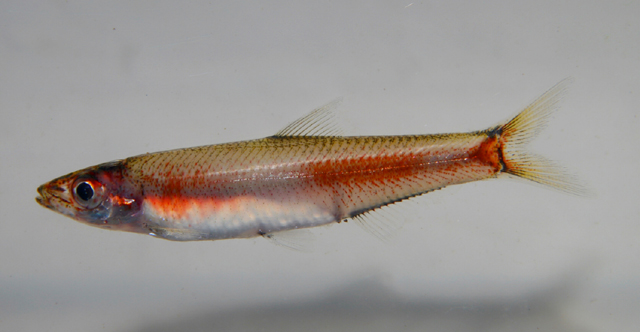| Ehiravidae (River sprats) |
| 6.62 cm SL (male/unsexed) |
|
pelagic; freshwater; brackish |
| Africa: mid and lower reaches of eastern coastal rivers and Pangalanes Canal network in Madagascar (Ref. 188, 33664). |
|
Dorsal spines (total): 0-0; Dorsal soft rays (total): 13-17; Anal spines: 0-0; Anal soft rays: 17-19; Vertebrae: 41-43. Diagnosis: Body elongate, a little compressed; belly rounded, without pre-pelvic scutes, but a pelvic scute present with slender lateral arms; gillrakers few, 17-20 gillrakers on lower limb of first arch; pelvic fin with 1 unbranched and 7 branched finrays, a little anterior to dorsal fin origin; last two anal finrays not separate from others (Ref. 188, 33664). It is distinguished from other non-scuted clupeids of Spratelloides, Dussumieria and Etrumeus by presence of a normal pelvic scute vs. W-shaped (Ref. 188). It is distinguished from Sauvagella robusta by a higher vertebral number, 41-43 vs. 38-40; a shallower body, 15.8-21.1% of standard length vs. 20.8-27.4%; a longer snout, 26.2-33.7% of head length vs. 18.5-26.6%; and a higher anal fin ray count, 17-19 vs. 13-17 (Ref. 33664).
Description: Gracile, torpedo-shaped fishes with straight dorsal profile and little ventral curvature; snout acutely pointed and narrow, mouth slightly upturned; gape inclination approximately 30° to horizontal; upper jaw to vertical through anterior margin of orbit (Ref. 33664). Pre-maxilla with dentigerous arm extending over anterior half of maxillary shaft; pre-maxillary teeth small unicuspids, 10-12 in single row; ventral margin of maxillary flange usually serrate; single, tear-shaped posterior supra-maxilla; lower jaw teeth in single row, small unicuspids extending over anterior half of dentary (Ref. 33664). Gill rakers: 17-20 on lower limb of first arch; 8-10 elongate hypobranchial rakers, increasing in length to ceratobranchial; 11-14, narrow, elongate rakers on ceratobranchial; usually 1 raker in angle of arch; and 9-12 epibranchial rakers; row of short rakers on inner face of third epibranchial (Ref. 33664). Dorsal fin relatively long-based, usually with 3 unbranched and 10-14 branched rays; anal with 3-4 unbranched and 14-15 branched rays, origin just below or slightly anterior to end of dorsal; ventral margin of anal straight or slightly incised; pectoral fin with 11-12 rays; pelvic fin with 1 unbranched and 7 branched rays, its insertion anterior to dorsal fin origin; caudal fin emarginate with deeply forked lobes (Ref. 33664, 121271). Scales are cycloid and easily shed; 43-45 scales in longitudinal series; 8 transversal scales (Ref. 56161, 121271). Belly rounded, lacking pre-pelvic scutes and post-pelvic scutes; pelvic scute with slender lateral arms (Ref. 9391, 33664, 56161). Vertebral counts 41-43 with 22-24 precaudal and 17-19 caudal centra; first supraneural bone flat and platelike, remaining 11-12 short and tubular; hyoid arch with 5 branchiostegal rays, first narrow and filamentous, rest variously expanded, flat and broad; single row of small teeth on ectopterygoid and rodlike palatine except in smallest individuals which sometimes lack palatine dentition (Ref. 33664).
Colouration: In life, rather nondescript uniformly pale yellow with silvery iridescence on head and flanks; some larger specimens dark orange, even reddish (Ref. 33664). Preserved specimens are pale creamy yellow with varying amounts of pigment ringing dorsal scale margins, darkening the dorsum; a thin midlateral band of dark pigment is often present on flanks; dorsal, anal and caudal fins usually with a line of dark pigment along base on the body wall; silvery or black peritoneal lining of abdominal cavity often visible through body wall; pupil situated anteriorly in eye, iris silver (Ref. 33664). |
| Found in freshwaters, possibly tolerating brackish water (Ref. 188); from sea level to about 450m, mostly in smaller rivers and streams and usually in forested areas (Ref. 56161). Probably planktivorous (Ref. 56161). |
|
Least Concern (LC); Date assessed: 29 June 2016 Ref. (130435)
|
| harmless |
|
Type locality of the syntypes of Spratelloides madagascariensis, more specifically the holotype of Sauvagella madagascariensis longianalis and the holotype of Sauvagella madagascariensis brevidorsalis: 'Madagascar' (Ref. 42522, 94656). Known from mid and lower reaches of eastern coastal drainages (Ref. 33664, 56151, 56161) and Pangalanes Canal network (Ref. 13296, 33664), from Manajary River in the south to Manamara River in the north (Ref. 33664), including Mangoro River (Ref. 26236), Lake Tampolo (Ref. 33664), Maningory River (Ref. 33664) and Lokoho River (Ref. 33664). More extensive sampling will no doubt extend that range (Ref. 33664). Also reported from Lake Kinkony (Ref. 13296), but its presence in the northwest of Madagascar is unconfirmed (Ref. 33664). Also Ref. 188, 3509, 9391, 13333, 43240, 94656, 117496, 117576. |
Source and more info: www.fishbase.org. For personal, classroom, and other internal use only. Not for publication.

